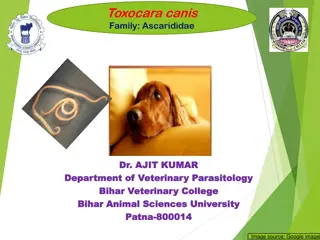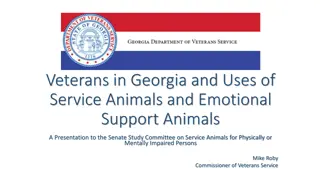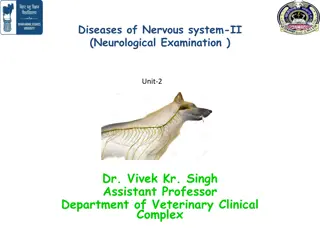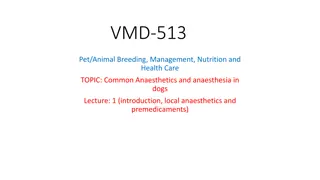Benefits of Dogs in School Settings
Review of research on the benefits of dogs in schools, including increased reading and language skills, social and emotional skills, and improved gross motor skills. Overcoming barriers such as hygiene, fear of dogs, and allergies is discussed. Additional resources and references provided.
Download Presentation

Please find below an Image/Link to download the presentation.
The content on the website is provided AS IS for your information and personal use only. It may not be sold, licensed, or shared on other websites without obtaining consent from the author.If you encounter any issues during the download, it is possible that the publisher has removed the file from their server.
You are allowed to download the files provided on this website for personal or commercial use, subject to the condition that they are used lawfully. All files are the property of their respective owners.
The content on the website is provided AS IS for your information and personal use only. It may not be sold, licensed, or shared on other websites without obtaining consent from the author.
E N D
Presentation Transcript
Dogs in the school setting Research-Based Benefits and best practices
In 2017 Jerri J. Kropp and Mikaela M. Shupp wrote a review of the research on dogs in schools for the Forum on Public Policy Online. They reviewed 30 sources, including Journal articles, chapters from books, and other sources, published between 2001 and 2017. Research shows there are multiple benefits to having dogs in schools The studies, spanning a decade and a half, included children from age 3 through high school. They found overwhelming evidence that supports the use of dogs in schools.
3 Types of Benefits INCREASED READING AND LANGUAGE SKILLS INCREASED SOCIAL AND EMOTIONAL SKILLS IMPROVED GROSS MOTOR SKILLS
Perceived Barriers to bringing dogs into schools HYGIENE/CLEANLINESS FEAR OF DOGS ALLERGIES
Hygiene: have students wash hands after handling dog How to overcome these barriers Allergies: parents sign a release form before beginning the program, so teachers and administrators can ensure students are able to participate Fear of dogs: require Canine Good Citizen certificate and qualified handlers (see AKC Canine Ambassador program)
Canine Ambassadors Check our registry publiced@akc.org to find an Ambassador near you, or email publiced@akc.org to volunteer to be a Canine Ambassador. How can the AKC help? Canine Clubs Everything you need to run an afterschool club about dog ownership, dog careers, dog shows and more. We provide all the materials. Be A Reading Kid Program Students read to a dog and earn prizes when they log their time.
publiced@akc.org publiced@akc.org Contact Us www.akc.org/public- education
Additional Resources and References Ascione, F., & Weber, C. (1996). Children s attitudes about the humane treatment of animals and empathy: One year followup of a school-based intervention. Anthrozoos, 9 (4), 188-195. Beck, Katie R., "The Impact of Canine-Assisted Therapy and Activities on Children in an Educational Setting" (2015). Education Masters. Paper 312. Delta Society (1999). Animals in the classroom. Renton, WA: Author. Delta Society. Delta Society Pet Partners Program home page (August 26, 2000). World wide web: http:// www.deltasociety.org. Fine, A. H. (2000). Animal-assisted therapy: Theoretical foundations and guidelines for practice. San Diego, CA: Academic Press. Gammonley, J., Howie, A. R., Jackson, B., Kaufman, M., Kirwin, Morgan, L., Rostan, K., S., Stuart-Russell, R., Triebenacher, S., & Zapf, S. A., (2000). Animal-assisted therapy: Therapeutic interventions. Renton, WA: Delta Society. Jalongo, M. R., Astorino, T. & Bomboy, N. (2004). Canine visitors: The influence of therapy dogs on young children s learning and well-being in classrooms and hospitals. Early Childhood Education Journal 32(1), 9-16. Retrieved from https://static1.squarespace.com/static/5b1ab385b105983abfb3668a/t/5b3174962b6a28c38306aea3/1529967766342/Canine-visitors-the- influence-of-therapy-dog+Aug2004.pdf Levinson, B.M. (1962). The dog as a co-therapist. Mental Hygiene, 46, 59-65. Levinson, B. M. (1969). Pet oriented child psychotherapy. Springfield, IL: Charles C. Thomas. Siegel, W. L. (2004). The Role of animals in Education. Revision, 27(2), 17-26. Retrieved from https://fisherpub.sjfc.edu/cgi/viewcontent.cgi?article=1313&context=education_ETD_masters Pillow-Price, K., Yonts, N., & Stinson, L. (2014). Sit, Stay, Read: Improving Literacy Skills Using Dogs. Dimensions of Early Childhood, 42(1), 5-9.
Additional Resources and References, Contd. Berry, A., Borgi, M., Francia, N., Alleva, E., & Cirulli, F. (2013). Use of Assistance and Therapy Dogs for Children with Autism Spectrum Disorders: A Critical Review of the Current Evidence. Journal Of Alternative & Complementary Medicine, 19(2), 73-80. doi:10.1089/acm.2011.0835 Chandler, C. K. (2001). Animal-assisted therapy in counseling and school settings. ERIC Clearinghouse on Counseling and Student Services. Friesen, L. (2009). Exploring animal-assisted programs with children in school and therapeutic contexts. Early Childhood Education Journal 37, 261-267. Geist, T. (2011). Conceptual Framework for Animal Assisted Therapy. Child & Adolescent Social Work Journal, 28(3), 243-256. doi:10.1007/s10560-011- 0231-3 Jalongo, M. R. (2005). What are all these Dogs Doing at School? : Using Therapy Dogs to Promote Children's Reading Practice. Childhood Education, 81(3), 152-158. Animal-Assisted Therapy in Counseling and School Settings by Cynthia Chandler October 2001. Retrieved from https://www.counseling.org/resources/library/eric%20digests/2001-05.pdf McKibben, Sarah. (February, 2018). ASCD Education Update. Why Schools Are Going to the Dogs. Vol 60. No 2. Retrieved from http://www.ascd.org/publications/newsletters/education-update/feb18/vol60/num02/Why-Schools-Are-Going-to-the-Dogs.aspx























